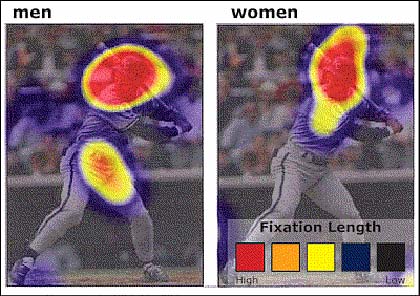Perhaps the highest praise I can offer for Helvetica comes courtesy of Meg, who was snickering on the way into the theater about going to see a movie about a font and exited saying, “that was great, now I want to be a designer!” The rest of the audience, mostly designers and type folks, loved it as well. But for the non-design folks, what’s compelling about the movie is getting a glimpse of how designers think and work; that it’s not just about making things look pretty. The modern world is awash in signage and symbols and words and for a lot of them, especially the corporate messages, there’s a reason why they look the way they do. The story of Helvetica offers a partial key to decoding these messages.
Check out some clips from the film and the screenings schedule to find out when Helvetica will be showing in your area. Thanks to the fine folks at Veer for inviting me to the screening.
Among the many interesting things in Online Journalism Review’s article about using eyetracking to increase the effectiveness of news article design is this odd result:

Although both men and women look at the image of George Brett when directed to find out information about his sport and position, men tend to focus on private anatomy as well as the face. For the women, the face is the only place they viewed. Coyne adds that this difference doesn’t just occur with images of people. Men tend to fixate more on areas of private anatomy on animals as well, as evidenced when users were directed to browse the American Kennel Club site.
That is absolutely fascinating. I’d love to hear an evolutionary biologist’s take on why that is.
I’m also heartened by the article’s first featured finding: that tighter writing, more white space, and jettisoning unnecessary imagery helps readers read faster and retain more of what they’ve read.
Not sure why I’m surprised, but when Apple came up with the idea for their Apple Stores, they appoached the design of the stores like they would any other product: they built a prototype first:
“One of the best pieces of advice Mickey ever gave us was to go rent a warehouse and build a prototype of a store, and not, you know, just design it, go build 20 of them, then discover it didn’t work,” says Jobs. In other words, design it as you would a product. Apple Store Version 0.0 took shape in a warehouse near the Apple campus. “Ron and I had a store all designed,” says Jobs, when they were stopped by an insight: The computer was evolving from a simple productivity tool to a “hub” for video, photography, music, information, and so forth. The sale, then, was less about the machine than what you could do with it. But looking at their store, they winced. The hardware was laid out by product category - in other words, by how the company was organized internally, not by how a customer might actually want to buy things. “We were like, ‘Oh, God, we’re screwed!’” says Jobs.
But they weren’t screwed; they were in a mockup. “So we redesigned it,” he says. “And it cost us, I don’t know, six, nine months. But it was the right decision by a million miles.” When the first store finally opened, in Tysons Corner, Va., only a quarter of it was about product. The rest was arranged around interests: along the right wall, photos, videos, kids; on the left, problems. A third area - the Genius Bar in the back - was Johnson’s brainstorm.
Lots of other great stuff in the article as well. Sounds like the Apple Store is an underrated piece of Apple technology.
Every few months, the blogosphere addresses the matter of gender diversity of speakers at conferences about design, technology, and the web. The latest such incidents revolved around the lack of women speakers at the the Future of Web Apps conference in San Francisco last September1 and the Creativity Now conference put on by Tokion in NYC last October. Each time this issue is raised, you see conference organizers publicly declare that they tried, that diversity is a very important issue, and that they are going to address it the next time around.
With that in mind, I collected some information2 about some of the most visible past and upcoming conferences in the tech/design/web space. I’m reasonably sure that the organizers of these conferences were aware of at least one of the above recent complaints about gender diversity at conferences (they were both linked widely in the blogosphere), so it will be interesting to see if those complaints were taken seriously by them.
Future of Web Apps - San Francisco
September 13-14, 2006
0 women, 13 men. 0% women speakers.
Tokion Magazine’s 4th Annual Creativity Now Conference
October 14-15, 2006
6 women, 30 men. 17% women speakers.
PopTech 2006
October 18-21, 2006
8 women, 30 men. 21% women speakers.
Web Directions North
February 7-10, 2007
5 women, 16 men. 24% women speakers.
LIFT
February 7-9, 2007
10 women, 33 men. 23% women speakers.
Future of Web Apps - London
February 20-22, 2007
1 woman, 26 men. 4% women speakers.
TED 2007
March 7-10, 2007
12 women, 41 men. 23% women speakers.
SXSW Interactive 2007
March 9-13, 2007
147 women, 378 men. 28% women speakers.
164 women, 373 men. 31% women speakers. (updated 2/22/2007)
165 women, 379 men. 30% women speakers. (updated 3/31/2007)
BlogHer Business ‘07
March 22-23, 2007
43 women, 0 men. 100% women speakers.
An Event Apart Boston 2007
March 26-27, 2007
1 woman, 8 men. 11% women speakers.
O’Reilly Emerging Technology Conference
March 26-29, 2007
9 women, 44 men. 17% women speakers.
12 women, 79 men. 13% women speakers. (updated 3/31/2007)
Web 2.0 Expo 2007
April 15-18, 2007
17 women, 91 men. 16% women speakers.
Future of Web Design
April 18, 2007
2 women, 12 men. 14% women speakers.
4 women, 16 men. 20% women speakers. (updated 3/31/2007)
GEL 2007
April 19-20, 2007
2 women, 11 men. 15% women speakers.
1 woman, 16 men. 6% women speakers. (updated 3/31/2007)
MIX07
April 30 - May 2, 2007
0 women, 4 men. 0% women speakers.
8 women, 89 men. 8% women speakers. (updated 3/31/2007)
The New Yorker Conference 2007
May 6-7, 2007
3 women, 21 men. 13% women speakers. (updated 2/28/2007)
6 women, 29 men. 17% women speakers. (updated 3/31/2007)
Dx3 Conference 2007
May 15-18, 2007
5 women, 48 men. 9% women speakers. (updated 3/2/2007)
5 women, 70 men. 7% women speakers. (updated 3/31/2007)
An Event Apart Seattle 2007
June 21-22, 2007
0 women, 9 men. 0% women speakers.
1 women, 9 men. 10% women speakers. (updated 3/31/2007)
From this list, it seems to me that either the above concerns are not getting through to conference organizers or that gender diversity doesn’t matter as much to conference organizers as they publicly say it does. The Future of Web Apps folks seem to have a particularly tin ear when it comes to this issue. For their second conference, they doubled the size of the speaker roster and added only one woman to the bill despite the complaints from last time. This List of Women Speakers for Your Conference compiled by Jen Bekman is a little non-web/tech-heavy, but it looks like it didn’t get much use in the months since its publication. Perhaps it’s time for another look. (If you think this issue is important, Digg this post.)
Update: To the above list, I added An Event Apart Boston 2007 and corrected a mistake in the count for GEL 2007 (they had one more woman and one less man than I initially counted.) Ryan Carson from Carson Systems, the producers of The Future of Web Apps conferences, emailed me this morning and said that my “facts just aren’t correct” for the count for their London conference. He stated that the number of speakers they had control over was only 13. Some of the speakers were workshop leaders (the workshops “are very different” in some way) and others were chosen by sponsors of the conference, not by Carson Systems. I’m keeping the current count of 27 total speakers as listed on their speakers page this morning…they’re the people they used to promote the conference and they’re the people at the conference in the front of the room, giving their views and leading discussions for the assembled audience. (thx, erik, mark, and ryan)
Update: I added the Future of Web Design conference to the above list. (thx, jeff)
Update: Hugh Forrest wrote to update me on the latest speaker numbers for SXSW Interactive 2007 (he keeps close watch on them because the issue is an important and sensitive one to the SXSW folks)…the ones on their site were less than current. In cases where counts are updated (and not inaccurate due to my counting errors), I will append them to the conference in question so that we can see trends. I plan to update the above list periodically, adding new conferences and keeping track of the speaker numbers on upcoming ones.
[1] Sadly, when I Googled “future of web apps women” while doing some research for this post, Google asked “Did you mean: ‘future of web apps when’”? ↩
[2] All statistics as of 2/22/2007. Consider the gender counts rough approximations…in some cases, I couldn’t tell if a certain person was a man or a woman from their name or bio. ↩
[3] This conference has released only a very incomplete speaker list. ↩
Designers often have the design disease, where you “can’t stop looking at things through your designer eyes”. “But it’s not just books, it’s everything. You’ll choose wine by the design of the label and you’d stay [at a hotel] because of the sign.” (via emdashes)
Update: Bruce writes: “A parallel affliction to the Design Disease is Climber’s Complaint, wherein someone who takes up rock climbing begins to see every object and architecture as potentially climbable. Similarly, Skater’s Disorder afflicts those for whom every surface is seen to exhibit some measure of skate-worthiness.”
By now you’ve all heard about the iPhone and read 60 billion things about it, so I’ll get straight to it. I’ve been tracking some of the best points from around the web and jotted down some thoughts of my own.
Caveat: Evaluating an interface, software or hardware, is difficult to do unless you have used it. An interface for something like a mobile phone is something you use on the time-scale of weeks and months, not minutes or hours. There are certain issues you can flag as potential problems, challenges, or triumphs after viewing demos, descriptions of functions, and the like, but until you’re holding the thing in your hand and living with it day-to-day, you really can’t say “this is going to work this way” or “I don’t like the way that functions” with anything approaching absolute confidence. With that said:
- In his keynote announcing it, Steve Jobs said the killer app for the iPhone was voice. The thing is, many people you talk to who are are under 35 use their phones more and more for text and less and less for voice. Same thing for Treo and Blackberry aficionados. Does the text entry via the touchscreen work as well as text entry via a mini keyboard? The tactility of raised buttons provides a lot of feedback to the typer’s fingers that a touchscreen does not. (Jason Fried said: “When you touch the [iPhone] it doesn’t touch you back.”) Can you type on it with your thumbs? What about if your thumbs are large? I know people who can text without looking at the keypad and/or Blackberry keyboard, that’s out the window with the touchscreen. Can you dial with one hand?
The touchscreen text entry is the biggest issue with the iPhone. If it works well, the iPhone has a good shot at success, and if not, it’s going to be very frustrating for those that rely on their mobile for text…and every potential customer of the iPhone is going to hear about that shortcoming and shy away.
- The price is pretty high. So was the price for the first iPod. And the Macintosh. Apple will approach this in a similar way to the iPod…start with a premium product at the high end and work their way down to shuffle-land. It isn’t difficult to imagine an iPhone nano that just does voice, SMS, music, and a camera. (Or an iPhone shuffle…you press the call button and it randomly calls someone from the ten contacts the shuffle synched from your computer that morning.)
- I guess we know why iPod development has seemed a little sluggish lately. When the Zune came out two months ago, it was thought that maybe Apple was falling behind, coasting on the fumes of an aging product line, and not innovating in the portable music player space anymore. I think the iPhone puts this discussion on the back burner for now. And the Zune? The supposed iPod-killer’s bullet ricocheted off of the iPhone’s smooth buttonless interface and is heading back in the wrong direction. Rest in peace, my gentle brown friend.
- How long before the other iPods start working like the iPhone? I imagine a widescreen video iPod with touchscreen but without a phone, wifi, camera, etc. will be introduced at some point after the iPhone comes out in June. Without the need for the clickwheel, the shape of the video and nano iPods becomes much more flexible. If they can cram all the memory and electronics into a smaller space, the nano could be half its current height with a touchscreen.
- What’s really kind of sad about the intensely exuberant reaction to the iPhone is that the situation with current mobile phones are so bad in the first place. It’s not like we didn’t see any of this coming or couldn’t imagine the utility of the iPhone’s features. Visual voicemail is a good idea, but the reason Nokia or Motorola didn’t introduce it years ago is that the carriers (Sprint, Verizon, T-Mobile, etc.) don’t want to support it despite its obvious utility and ease of implementation. (T-Mobile sends my Nokia phone a text message every time I get a voicemail…what could be simpler than sending the number along with it and shunting those messages to a special voicemail app on the phone to see a list of them? Listening to them out of sequence would be a bit harder, but doable. Blackberry announced they were doing this back in 2005.) Integrated Google Maps, email, and search makes obvious sense too. As for the touchscreen, we’ve all seen Jeff Han’s work on multi-touch interaction, Minority Report, and Wacom’s Cintiq, not to mention the mousepads on the MacBooks and the iPod’s clickwheel. The Japanese are pretty unimpressed with the whole thing.
What *is* fantastic about the iPhone is the way that they’ve put it all together; features are great, but it’s all about the implementation. Apple stripped out all the stuff you don’t need and made everything you do need really simple and easy. (That’s the way it appears anyway…see above caveat.)
- Regarding the above, a relevant passage from a Time magazine article on how the iPhone came about:
One reason there’s limited innovation in cell phones generally is that the cell carriers have stiff guidelines that the manufacturers have to follow. They demand that all their handsets work the same way. “A lot of times, to be honest, there’s some hubris, where they think they know better,” Jobs says. “They dictate what’s on the phone. That just wouldn’t work for us, because we want to innovate. Unless we could do that, it wasn’t worth doing.” Jobs demanded special treatment from his phone service partner, Cingular, and he got it. He even forced Cingular to re-engineer its infrastructure to handle the iPhone’s unique voicemail scheme. “They broke all their typical process rules to make it happen,” says Tony Fadell, who heads Apple’s iPod division. “They were infected by this product, and they were like, we’ve gotta do this!”
- From the video, it looks like it take four clicks (after unlocking the phone) to make a phone call. For everyday use, that seems excessive. I hope there’s going to be some sort of speed dial mechanism…with my current phone, pressing “2” and then “send” calls my wife (which I can basically do without looking, BTW).
- I don’t know what the state of the art is in voice recognition these days, but I’m a little surprised that’s not an input option here. To call someone, you say their name (my current phone does this). To text someone, you speak the message and they get the text on their end. Speaking “Google Maps, sushi near 10003” would have the expected result.
- Or maybe drawing graffiti on the screen with your fingers and other gestural input methods? You could have different swipes and taps as a speed dial mechanism…swipe the screen from top left to bottom right and then tap in the lower right hand corner to call mom, that sort of thing. Or Morse code maybe? ;)
- The OS X included with the phone obviously isn’t the version that’s running on my Powerbook right now. John Gruber proves that footnotes are often more interesting than the referring text and offers this little tidbit:
That is to say the core operating system at the core of Mac OS X, the computer OS used in Macs, and “OS X”, the embedded OS on the iPhone. More on this soon in a separate fireball, but do not be confused: Mac OS X and OS X are not the same thing, although they are most certainly siblings. The days of lazily referring to “Mac OS X” as “OS X” are now over.
Several people have speculated that the iPhone’s version of OS X is actually a preview of what we’ll be getting with Leopard, the next version of Mac OS X.
- Lance warns us of the dreaded version 1.0 hardware from Apple.
- My favorite thing about the iPhone is the Google Maps integration. I would use that at least 4-5 times a week.
- Will phone numbers and addresses detected on web pages in Safari be clickable? Click to dial a phone number, click to look up an address with Google Maps, that sort of thing. Update: There’s a video online somewhere (anyone?) of a demo that shows a URL in an email and/or text message that’s clickable. (thx, Deron)
- The resolution of the screen on the iPhone is 160 ppi. People who have seen it close up report that the screen is extremely crisp and clear. Apple displays have been higher than 72 ppi for quite awhile, now but not as high as 160. How soon can we expect 160 ppi on the MacBooks?
- Double the width of the iPhone and you’ve got the iTablet. 640x480, a bigger virtual keyboard to type on, etc. Just a thought.
- My friend Chris suggested that it should ship with a dock that hooks directly to a monitor. Attach a keyboard and mouse to the monitor and voila!, you’ve got the world’s smallest portable computer.
- iPhone trademark dispute between Apple and Cisco: booorrrrr-ring.
- This is one of the biggest questions in the hardcore technology community: will Apple allow 3rd party development of widgets and apps for the iPhone? Right now it seems like they might not, but there’s a lot of speculation in the absence of information going on. It sure would be nice if they did, but Apple doesn’t have a good track record here. I bet the Dodgeball and Upcoming folks are looking at the integrated Google Maps and wishing they could integrate their apps in the same way. (And Flickr too!)
- Games! A no-brainer. Probably lots you can do with the motion sensors and proximity detectors, not to mention the touchscreen. Although the touchscreen does make it difficult to see and control the onscreen action at the same time. How would you play Pac-Man on the iPhone?
- Available in more than one color? Probably a few months after launch…or it could be right away.
- Parallels running on the iPhone was a joke, folks. Just pulling your ARM.
- Don’t you think that maybe every company should fire their founders after a few years and then hire them back a few years later? I mean, how crazy is it that Apple birthed the Apple II and the Macintosh — each a significant achievement that taken alone would have sealed Apple’s reputation for innovation in the history of computing — and then fired the guy that got them there, stumbled badly enough that they were heading for mediocrity and obscurity, and then brought Jobs back, who spurred a string of successes that has nearly overshadowed the company’s earlier achievements: OS X, the iMac, the iBooks/PowerBooks/MacBooks, the iPod, iTMS, and now the iPhone. It’s insane! Not to mention fun to watch. Perhaps Google should fire Larry and Sergey with the idea that they’ll take them back in a few years when they’re a little older, a little wiser, a little more seasoned in business, with a new perspective, and possessing an enormous amount of motivation to prove that their dismissal was a bad move.
- My favorite comment from the Digg thread about the model iPhone I made out of cardboard: “Nothing says you’ve never kissed a girl like toting around a paper iPhone.”
- From the Time article, a quote from Steve Jobs about how Apple does business: “Everybody hates their phone and that’s not a good thing. And there’s an opportunity there.”
- Interesting thoughts from Adam Baer in the wake of the iPhone announcement:
Apple has figured out a way to retain a hold on hearts and minds in a business previously based on bytes. I applaud its designs, I worry about its tactics and what they mean for the future of marketing and group think. A group that wants our devotion but doesn’t need the press, doesn’t want the press, can’t keep the press off its backs, is a group that’s more interested in mind control than in improving lives with its products.
- Some miscellaneous links: Watch the MacWorld keynote with the iPhone announcement. Fortune piece on how Apple kept the iPhone a secret for two years. David Pogue got an hour of hands-on time with the iPhone. The Digg post of the announcement got almost 20,000 diggs, more than 1,400 comments, and nearly crashed my browser when I went to look at it.
And that’s enough, I think.






Stay Connected